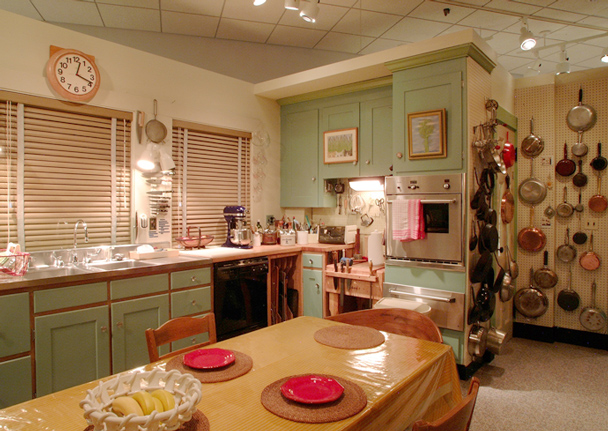In tandem with Julia Child's centennial, August 15, 2012, the Smithsonian Institution's National Museum of American History is marking a decade of success—and a big future—for its famous exhibit of Julia's kitchen. Titled Bon Appétit! Julia Child's Kitchen at the Smithsonian, the exhibit opened in August 2002 and quickly became one of the museum's best-loved attractions. To the dismay of many, the museum closed the exhibit in January 2012, albeit for a good cause: refreshing and reinstalling it as the centerpiece of Food: Transforming the American Table 1950–2000, a new, more comprehensive American food and wine exhibition slated to open this fall. To celebrate what would have been the iconic author and TV chef's 100th birthday, the museum is temporarily reopening Julia's kitchen to visitors from August 15 to September 3. After that, you'll have to wait until November, when Food is ready for public consumption.
At this turning point, Gourmet Live checked in with Paula Johnson and Rayna Green, the co-curators of Food, who also worked closely with Julia Child back in 2001. Learn how NMAH prepared for the acquisition of Julia's kitchen, what they found in her junk drawer, and why America can't get enough of the French Chef.
Gourmet Live: How did you learn about Julia Child's plans to leave Cambridge, Massachusetts—and her famous kitchen there—in 2001?
Paula Johnson: We learned about Julia Child's departure the same way many people did—from The New York Times. John Leland's article, "Change of Scene, if Not Cuisine," appeared on July 26, 2001, revealing Julia's plans to leave her home of 43 years and return to her native California and its milder winters. This is the sort of news that generates a frisson of speculation and causes museum curators to gather in corridors to ask a lot of questions, and in very special circumstances, to leap into action. For us at NMAH, we wondered: Is Julia alright? Who can we call? What will happen to the kitchen and all of her things? Can we meet with her? Shall we call her? The leaping had begun.
But on the way to that first phone call, we had to answer our own phones, which were ringing off the hook. Various friends and colleagues, foodies and culinary historians alike, were urging us to follow up with Julia. For them, it was a no-brainer: Julia Child's kitchen simply belonged at the Smithsonian, where it could be appreciated by her throngs of devoted fans, and inspire those who would surely become fans once they learned about her. Our approach had to be more deliberate, however, because of the huge commitment involved in acquiring artifacts for the national collections. "In perpetuity" is a long time, and that's the commitment we make to caring for the collections.
GL: What was the acquisitions process like?
PJ: Curator Rayna Green and project manager Nanci Edwards had met Julia years before at a Napa wine event, and they were the ones who dialed Julia's number. They were surprised to hear that familiar voice on the other end of the line when she answered the phone! When Rayna asked if we could schedule a visit, Julia invited us to "come ahead!" The three of us soon found ourselves climbing the rear stairs of Julia Child's home on Irving Street, which brought us right to the kitchen threshold.
As she welcomed us in, Julia suggested we all take a seat around the kitchen table, her favorite place for meeting with people and having conversations. We had gone up thinking we might simply discuss a donation of "the most significant" objects—her big Garland range, a set of whisks and knives, and perhaps the kitchen table—but once we got there, we all experienced another frisson: The entire room was the artifact. The arrangement of tools and work spaces; the 1960s color scheme; the simple cabinetry and butcher block countertops; the placement of pots and pans on Peg-Boards; the sheer number and variety of utensils above the range—all of these added up to tell a bigger, richer, deeper story than a handful of "significant" pieces ever could. We all agreed that we needed to ask her about collecting the entire kitchen.
We spent a day and a half inventorying all the contents of the 14- by 20-foot room. Julia allowed us access to every nook and cranny, and left us to our work. As Nanci and I measured the walls and cabinetry to create an accurate plan, Rayna video-recorded all the contents in the cabinets and drawers. We followed up with a complete listing of everything, categorized by location. The more we worked, the more we appreciated Julia's organizational style and her curatorial sensibilities. Her labels on various containers undoubtedly helped people working in her kitchen to put things back where they belonged, but they also helped us understand her more.



 Pinterest
Pinterest


